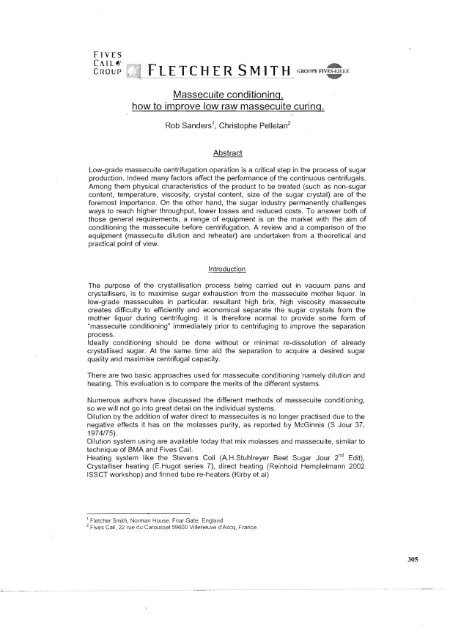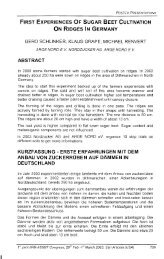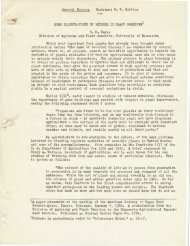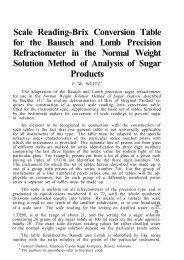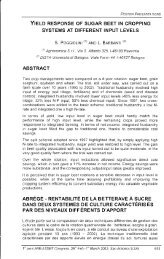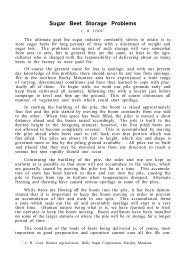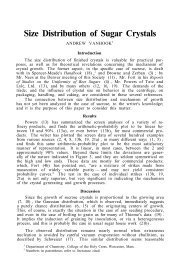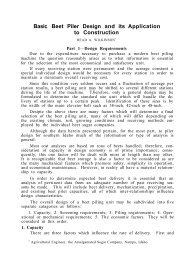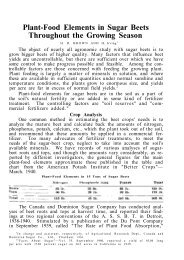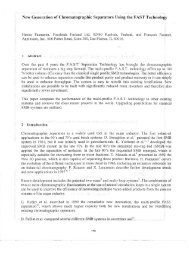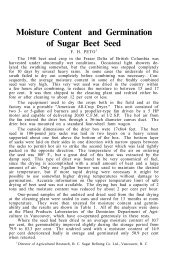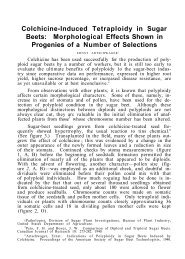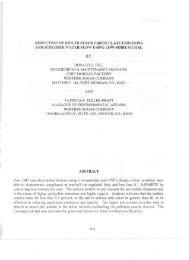Massecuite conditioning, how to improve low raw massecuite curing.
Massecuite conditioning, how to improve low raw massecuite curing.
Massecuite conditioning, how to improve low raw massecuite curing.
You also want an ePaper? Increase the reach of your titles
YUMPU automatically turns print PDFs into web optimized ePapers that Google loves.
<strong>Massecuite</strong> <strong>conditioning</strong>, <br />
<strong>how</strong> <strong>to</strong> <strong>improve</strong> <strong>low</strong> <strong>raw</strong> <strong>massecuite</strong> <strong>curing</strong>. <br />
Rob Sanders 1, Chris<strong>to</strong>phe Pelletan 2<br />
Abstract<br />
Low-grade <strong>massecuite</strong> centrifugation operation is a critical step in the process of sugar<br />
production. Indeed many fac<strong>to</strong>rs affect the performance of the continuous centrifugals.<br />
Among them physical characteristics of the product <strong>to</strong> be treated (such as non-sugar<br />
content, temperature. viscosity, crystal content, size of the sugar crystal) are of the<br />
foremost importance. On the other hand, the sugar industry permanently challenges<br />
ways <strong>to</strong> reach higher throughput, <strong>low</strong>er losses and reduced costs. To answer both of<br />
those general requirements, a range of equipment is on the market with the aim of<br />
<strong>conditioning</strong> the <strong>massecuite</strong> before centrifugation. A review and a comparison of the<br />
equipment (<strong>massecuite</strong> dilution and reheater) are undertaken from a theoretical and<br />
practical point of view.<br />
Introduction<br />
The purpose of the crystallisation process being carried out in vacuum pans and <br />
crystallisers. is <strong>to</strong> maximise sugar exhaustion from the <strong>massecuite</strong> mother liquor. In <br />
<strong>low</strong>-grade <strong>massecuite</strong>s in particular. resultant high brix. high viscosity <strong>massecuite</strong> <br />
creates difficulty <strong>to</strong> efficiently and economical separate the sugar crystals from the <br />
mother liquor during centrifuging. It is therefore normal <strong>to</strong> provide some form of <br />
"<strong>massecuite</strong> <strong>conditioning</strong>" immediately prior <strong>to</strong> centrifuging <strong>to</strong> <strong>improve</strong> the separation <br />
process. <br />
Ideally <strong>conditioning</strong> should be done without or minimal re-dissolution of already <br />
crystallised sugar. At the same time aid the separation <strong>to</strong> acquire a desired sugar <br />
quality and maximise centrifugal capacity. <br />
There are two basic approaches used for <strong>massecuite</strong> <strong>conditioning</strong> 'namely dilution and <br />
heating. This evaluation is <strong>to</strong> compare the merits of the different systems. <br />
Numerous authors have discussed the different methods of <strong>massecuite</strong> <strong>conditioning</strong>, <br />
so we will not go in<strong>to</strong> great detail on the individual systems. <br />
Dilution by the addition of water direct <strong>to</strong> <strong>massecuite</strong>s is no longer practised due <strong>to</strong> the <br />
negative effects it has on the molasses purity, as reported by McGinnis (S Jour 37, <br />
1974/75). <br />
Dilution system using are available <strong>to</strong>day that mix molasses and <strong>massecuite</strong>, similar <strong>to</strong> <br />
technique of SMA. and Fives Cail. <br />
Heating system like the Stevens Coil (A.H.Stuhlreyer Seet Sugar Jour 2 nd<br />
Edit). <br />
Crystalliser heating (E.Hugot series 7). direct heating (Reinhold Hemplelmann 2002 <br />
ISSCT workshop) and finned tube re-heaters (Kirby et al) <br />
, Fletcher Smith, Norm an House. Fria r Gate, England. <br />
2 Fives Cail. 22 rue du Caroussel 59600 Villeneuve d'Ascq. France. <br />
305
The Evaluation of Modern Conditioning Methods<br />
Basis for Evaluation<br />
For purpose of this evaluation we have considered a case for a fac<strong>to</strong>ry slicing 6,000<br />
<strong>to</strong>ns of beets per day and producing 20 <strong>to</strong>nnes per hour of <strong>low</strong> grade <strong>massecuite</strong>. Also<br />
used as an example what we regard as a reasonably typical beet <strong>low</strong> grade<br />
<strong>massecuite</strong> having a refrac<strong>to</strong>meter brix of 94 degrees and an apparent purity of 76. For<br />
determination of mother liquor supersaturation the formulae from Z. Budnik et al Sugar<br />
Tech Manual has been used arid it has been assumed that the molasses has the<br />
fol<strong>low</strong>ing coefficient a=0.230; b=0.770; c=1.S00.<br />
It is also assumed that the <strong>to</strong>tal <strong>massecuite</strong> and mother liquor obeys the viscosity<br />
relationship detailed in the formulae of Z. Budnik et al Sugar Tech Manual. An<br />
illustration of this relationship and of the effect that temperature has on <strong>massecuite</strong> and<br />
mother liquor viscosity during the crystalliser cooling stage is s<strong>how</strong>n in Figure 1. It can<br />
be seen that there is a steep viscosity increase when the cooling <strong>massecuite</strong> drops<br />
be<strong>low</strong> 50°C<br />
Effect of temperature on MIL viscosity<br />
5,000 66.00<br />
64.00<br />
Q) 4,000<br />
§<br />
:><br />
(; 58.00 a.<br />
:J 2, 000<br />
g<br />
Qj 56.00<br />
.c<br />
0 1,000<br />
:2<br />
54.00<br />
0 52.00<br />
40 50 60 70<br />
80<br />
Temp (' C)<br />
1- 94.5 deg Bx - 95.5 deg Bx -+- ML. Purity 1<br />
Figure 1 - Effect of Crystalliser cooling on <strong>massecuite</strong> viscosity<br />
306
Examples of modem conditioners:<br />
Although Stevens coil re-heaters are still common in a lot of existing fac<strong>to</strong>ries, they are<br />
not generally the choice for new installations. When new more modern installations are<br />
considered there are alternatives choices:<br />
Alternative Methods for C-<strong>massecuite</strong> Conditioning<br />
1) Re heating in the last section of a vertical crystalliser. <br />
2) Re heating in a dedicated finned tube re heater. <br />
3) Diluting with an inline dilu<strong>to</strong>r/conditioner. <br />
4) Re heating by direct steam injection of steam in<strong>to</strong> the <strong>massecuite</strong>. <br />
1) Re-heating in a crystalliser.<br />
Alternative evaluations<br />
Consider a <strong>low</strong> grade crystalliser is divided up in<strong>to</strong> two sections one for cooling<br />
and the other section for heating. The cooling section is sized for a thirty-six<br />
hour cooling time 0.81 deg C per hour. (480 cu M).<br />
The heating volume is sized adequately <strong>to</strong> heat the <strong>massecuite</strong> <strong>to</strong> saturation<br />
point while maintaining the same heating surface <strong>to</strong> volume ratio of 1.3 as per<br />
. the cooling section. Giving it a 12-hour retention, (160 cu M).<br />
For the purpose of the evaluation the cooling volume has been divided in<strong>to</strong> two<br />
sections, both cooling and heating waters are counter current <strong>to</strong> <strong>massecuite</strong><br />
f<strong>low</strong>s.<br />
Using a model with the parameters s<strong>how</strong>n in Figure 3 the mother liquor film is<br />
reduced <strong>to</strong> a level of saturation acceptable for easy centrifugal separation.<br />
<strong>Massecuite</strong> in 74°C<br />
Cooling water 61 °C out<br />
Section 1 cooling 57°C<br />
Section 2 cooling 57°C<br />
<strong>Massecuite</strong> 45°C<br />
M assecu ite out 56°C • • Heating ••<br />
section • •<br />
• • • •<br />
......_----....... <br />
Cooling water in 31·C<br />
Heating water out 59"C<br />
Heating water in 70"C<br />
Figure 2 - Model of crystal/iser cooling and heating scenario .<br />
307
Inlet area 1 Oulet area 1 Inlet area 2 Oulet area 2 Inlet area 3 Oulet area 3<br />
<strong>Massecuite</strong> F<strong>low</strong> Vh 20.0 20.0 20.0 20.0 20.0 20.0<br />
Brix % 94 94 94 94 94 94<br />
Purity % 76 76.0 76.0 76.0 76.0 76.0<br />
Crystal content % 30.0 36 .0 36.0 39.5 39.5 41.0<br />
Nutch brix % 91.4 90.6 90.6 90.1 90.1 89.8<br />
Nutch purity % 64.8 61.1 61..1 58.6 58.6 57.4<br />
Temperature 'c 74.0 57.0 57.0 45.0 45.0 56.0<br />
Supersaturation 1.24 1.29 1.29 1.32 1.32 1.12<br />
Film Surpersaturation 1.45 1.48 1.48 1.49 1.14 0.95<br />
Enthalpy kJl1
A disadvantage of this type of installation is the size and cost of the equipment<br />
required.<br />
The thermal balance is optimised in order <strong>to</strong> maintain the difference of<br />
temperature between the water and the <strong>massecuite</strong> so it is kept as constant as<br />
possible during the phase of cooling and heating. As can be noticed from<br />
figures 3 and 4, during the cooling phase, the supersaturation of the<br />
<strong>massecuite</strong> in close contact with the cooling tubes is higher than 1.45. This<br />
leads <strong>to</strong> a potential risk of fine crystal sugar formation or local encrustation on<br />
the cooling tube surface . On an other hand, during ,the heating phase, the<br />
temperature of the water in the tubes is such that the <strong>massecuite</strong> could be<br />
locally under saturated, in particular just before leaving the crystalliser.<br />
In conclusion it appears from this review that large vertical crystalliser with<br />
classical surface/volume ratio (SN
U<br />
60<br />
.. .. .. .. <br />
55<br />
.. <br />
1.3<br />
...<br />
:J<br />
~ ... 50<br />
1.1 ~ ...<br />
Q)<br />
.a<br />
~<br />
c<br />
Q) 0<br />
0<br />
E<br />
Q)<br />
I<br />
45<br />
1.2<br />
1.0<br />
ro<br />
CI)<br />
40 +------;-------r------~----_+------+ 0.9<br />
o 5 10 15 20 25<br />
Residence time (min)<br />
I~MC Temperature -<br />
- - MC Saturation I<br />
Figure 6 - Re-heater temperature & saturation profile<br />
Figure 6 assumes that the f<strong>low</strong> of <strong>massecuite</strong> through a conventional finned<br />
heater is linear, as it has a high heating surface with narrow <strong>massecuite</strong> voids.<br />
It is considered that a correctly designed heater does not channel as it is self<br />
regulating, with high <strong>massecuite</strong> f<strong>low</strong> passing over the heating elements less<br />
heat is absorbed. This tending <strong>to</strong> s<strong>low</strong> the rate of throughput, due <strong>to</strong> its change<br />
in its saturation/viscosity. When the rate s<strong>low</strong>s additional heat is taken in,<br />
again altering the <strong>massecuite</strong> al<strong>low</strong>ing the f<strong>low</strong> <strong>to</strong> increase.<br />
A Typical <strong>massecuite</strong> reheater<br />
310
Inlet<br />
Quiet<br />
<strong>Massecuite</strong> F<strong>low</strong> tIh 20.0 20.0<br />
Brix % 94 94<br />
Purity % 76.0 76.0<br />
Crystal content % 41.0 41.0<br />
Nutch brix % 89.8 89.8<br />
Nutch purity % 57.4 57.4<br />
Temperature DC 45.0 55.0<br />
Supersaturation 1.26 1.14<br />
Film Surpersaturation 1.14 1.02<br />
Enthalpy kJlkg 72 90<br />
Water F<strong>low</strong> tIh 23 23<br />
Temperature DC 54.6 64.6<br />
Enthalpy kJlkg 229 271<br />
DT MC-water DC 9.6 9.6<br />
DTof DT 0.0<br />
Volume m3 3.5<br />
SN m·l 114<br />
Thermal Surface m 2 400<br />
Exchange DTlog DC 13.19<br />
HTC w/m2.0 C 20.0<br />
Residence<br />
time<br />
hrs 0.3<br />
Figure 7 - Balance of finned tube reheater.<br />
Advantages of a finned re-heater are that it has a large heating surface area in <br />
a very compact area. For this particular model of 400sq m heating surface it <br />
has a <strong>massecuite</strong> volume of 3.5 cu M. Giving a heating surface <strong>to</strong> volume ratio <br />
of 114 m2/m3, with a <strong>massecuite</strong> average retention time of 20 minutes within <br />
the heating section, therefore eliminating the risk of crystals dissolution. <br />
Another advantage is that they are completely sealed with no moving parts <br />
and require little maintenance. <br />
3) <strong>Massecuite</strong> diluter<br />
Principle of the process<br />
A conditioner is normally positioned in the main <strong>massecuite</strong> pipeline between a <br />
crystalliser and centrifugal installation. This type of conditioner is normally <br />
designed <strong>to</strong> work under extreme pressures. Ideally they would be installed <br />
close <strong>to</strong> a cooling crystalliser outlet reducing the pressure loses in the pipe <strong>to</strong> <br />
the continuous centrifugals. In modern sugar fac<strong>to</strong>ries with high capacity <br />
vertical crystallizers high pressures are exerted on sealing arrangements. With <br />
the latest development in seals Fives Cail I Fletcher Smith <strong>massecuite</strong> diluters <br />
are now designed <strong>to</strong> work with 8 bar as a nominal pressure. <br />
Dilu<strong>to</strong>rs requires that the mixing molasses used for dilution be diluted and <br />
temperature adjusted prior <strong>to</strong> it being mixed in<strong>to</strong> the <strong>massecuite</strong>. <br />
311
Cold and viscous<br />
Ma ssecuite<br />
MC DILUTER<br />
Diluted <strong>Massecuite</strong><br />
Diluted and reheated Mola sses<br />
(10% maxof MC flaw)<br />
Figure 8 - G. A. of a massecuffe diluter<br />
High-pressure <strong>massecuite</strong> diluters are made up of a cylinder shell that can be<br />
installed horizontally or vertically. It is a self-setting device that can be installed<br />
in line with an existing <strong>massecuite</strong> pipeline. The principal of operation is <strong>to</strong><br />
highly shear the <strong>massecuite</strong> and the molasses, in order <strong>to</strong> achieve a perfect<br />
homogenization of the product within a very small volume. A cantilever shaft is<br />
connected <strong>to</strong> a mo<strong>to</strong>r-reducer on one end, on the rotating shaft there are<br />
several rows of four 90· oriented cross blades. In normal operation the<br />
rotational speed of the shaft averages 100 rpm. The counter blades connected<br />
<strong>to</strong> the internal shell enhance the mixing of the 2 products. A cus<strong>to</strong>m seal<br />
al<strong>low</strong>s the conditioner <strong>to</strong> work under high-pressure <strong>massecuite</strong> without any<br />
leak of mother liquor.<br />
Nominal<br />
Diameter<br />
(mm)<br />
500<br />
350<br />
250<br />
200<br />
Installed<br />
power<br />
(kW)<br />
30<br />
7.5<br />
5.5<br />
2.2<br />
Rotation<br />
speed<br />
(rpm)<br />
98<br />
139<br />
178<br />
225<br />
<strong>Massecuite</strong><br />
F<strong>low</strong><br />
Tm/h<br />
60<br />
30<br />
15<br />
10<br />
Number of<br />
blades 1<br />
counter blades<br />
12/16<br />
6/12<br />
6/4<br />
4/3<br />
Shear<br />
Number 1<br />
revolution<br />
96<br />
36<br />
12<br />
8<br />
Figure 9 - Characteristic of Fives Cail / Fletcher Smith high pressure <strong>massecuite</strong> dilute<br />
312
VERTICAL SEITINGS<br />
'"':::: \<br />
MASSEcurre<br />
jFEED<br />
M~<br />
FEE \<br />
\<br />
OUTLET<br />
MASSECurrE<br />
DILUTED<br />
\<br />
OOTLET<br />
MASSECUfTE<br />
DILUTED<br />
Figure 10 - General arrangement d<strong>raw</strong>ing of a Fives Gail diluter<br />
The advantages of mixing/<strong>conditioning</strong> are the fol<strong>low</strong>ing:<br />
2 actions simultaneously, one dilution, one reheating<br />
Gontrol of the final supersaturation of the final <strong>massecuite</strong><br />
Lower <strong>massecuite</strong> viscosity. Indeed for the same final mother liquor viscosity, as<br />
s<strong>how</strong>n in the comparison table, the <strong>massecuite</strong> viscosity is much <strong>low</strong>er than with<br />
reheating systems (surface heaters or direct steam injection). The <strong>massecuite</strong><br />
viscosity can be decreased up <strong>to</strong> 30%.<br />
The <strong>massecuite</strong> temperature (at 50 0 G max) and the molasses temperature (at<br />
60 0 G max) remain <strong>low</strong>, which can be an advantage in relation with the s<strong>to</strong>rage of<br />
this by-product.<br />
Some specific disadvantages remain:<br />
Necessity of a powerful and efficient mixer, which absorbs electrical power.<br />
A control system is necessary. The control system is based on the fol<strong>low</strong>ing 2<br />
principles:<br />
1. The molasses temperature and dry matter shall be<br />
maintained constant.<br />
2. The f<strong>low</strong> of molasses shall be adjusted according <strong>to</strong> the<br />
intensity absorbed by the diluter mo<strong>to</strong>r.<br />
The quantity of final <strong>massecuite</strong> <strong>to</strong> be treated is increased by 7 <strong>to</strong> 8 %.<br />
313
4) Re-heatinq with direct contact steam.<br />
Steam heating is undertaken by introducing steam directly in<strong>to</strong> the f<strong>low</strong> of<br />
<strong>massecuite</strong> entering the centrifugal. The most critical step of this operation is<br />
the efficiency of the mixing between the steam and the <strong>massecuite</strong>. Because<br />
of the high <strong>massecuite</strong> viscosity it is not easy <strong>to</strong> mix with any product, and in<br />
particular with steam. A specific mechanical device is . generally needed in<br />
order <strong>to</strong> insure a homogeneous mixing. Figure 11 s<strong>how</strong>s the effect of steam<br />
mixing with <strong>massecuite</strong>. There will be thermal losses attributed <strong>to</strong> this method,<br />
as often experienced as indicated on Figure 11 .<br />
Incidence thennal Losses<br />
2.00% 55.0<br />
1.75%<br />
I---- -::---..<br />
~1 . 50% /<br />
1-----,______. /"<br />
;><<br />
,.,.---:' ~<br />
0.75%<br />
o.SO% ~--------- ~--<br />
C><br />
-'"<br />
~<br />
~1 . 25%<br />
E<br />
co<br />
3; H XJ%<br />
~<br />
~<br />
~<br />
r-<br />
0% 5% 10% 15% 20% 25% 30% 35% 40%<br />
I-u- Steam RON -(}- terrpErnttre I>IC I<br />
V<br />
/<br />
52.5<br />
sooE<br />
..<br />
~<br />
::J<br />
0.<br />
Ẹ.<br />
47.5 :.<br />
...<br />
45.0 u<br />
::li:<br />
42 5<br />
40.0<br />
Figure 11 - In.cidence ofthe thermal losses on the performance of thfJ direct steam<br />
injection system<br />
314
Cooled<br />
<strong>Massecuite</strong><br />
Massecurte<br />
Massecurte Massecuile a~er<br />
a~er<br />
before a~er Molasses Dilution Steam direct<br />
Condrtionnin healing injection<br />
g<br />
F<strong>low</strong>rate mTIh 20.00 20.00 2.18 22.18 0.15 20.15<br />
'.<br />
Brix % 94.00 94.00 77.00 92.33 93.30<br />
Purity %<br />
Brix of molher liquor %<br />
Purity of mother liquor %<br />
Crystal content %<br />
Temperature<br />
Pressure<br />
'C<br />
bar A<br />
76.00 76.00 59.00 74.61 76.00<br />
89.83 89.83 87.83 88.71<br />
57.43 57.43 57.65 57.43<br />
41.00 41.00 36.97 40.70<br />
45.0 60.6 80.0 49.7 115.0 54.3<br />
Cp kJJ1
Advantages<br />
Disadvantages<br />
Crystalliser Possible phased fac<strong>to</strong>ry Small heating surfaces <strong>to</strong> volume<br />
Re-heating upgrades. ratio.<br />
Need high input levels of<br />
management, long lag times for a<br />
control system. Good instrumentation<br />
control required. Risk of localised<br />
over heatinf).<br />
Finned tube No moving parts, <strong>to</strong>tally Instrumentation <strong>to</strong> control water<br />
Re-heating sealed. Large heating surface<br />
<strong>to</strong> volume ratio.<br />
temperatures.<br />
Inline Can be installed in<strong>to</strong> confined Moving parts.<br />
<strong>conditioning</strong> spaces. Additional 7 - 8% loading on the<br />
centrifugal. Conditioning of mixing<br />
molasses. High degree of<br />
instru mentation.<br />
Direct<br />
heating<br />
Simple <strong>to</strong> install. Often<br />
provided by the centrifugal<br />
supplier.<br />
High risk of crystal losses and purity<br />
rise. Difficult <strong>to</strong> control, when mass<br />
f<strong>low</strong>s vary.<br />
An interesting feature with centrifugal should also <strong>to</strong> be considered before <strong>conditioning</strong><br />
<strong>massecuite</strong>. This feature is basket angle <strong>to</strong> suit different grades of <strong>massecuite</strong>. Even though<br />
most of the centrifugal suppliers propose only one basket angle for standardisation of their<br />
production, it is not hard <strong>to</strong> understand that if a basket angle is well adapted <strong>to</strong> treat a given<br />
<strong>massecuite</strong> (say B <strong>massecuite</strong> for a 30° angle basket) with specific characteristics (temperature,<br />
purity, crystal size, etc), it will be much harder <strong>to</strong> work with the same basket on a <strong>massecuite</strong><br />
with smaller crystal, <strong>low</strong>er temperature, and higher viscosity such as <strong>low</strong> grade <strong>massecuite</strong>. In<br />
this case, a <strong>massecuite</strong> <strong>conditioning</strong> will be required <strong>to</strong> achieve good crystal separation<br />
-;0' ,<br />
.J<br />
\ .<br />
Figure 14 - Relative geometry of continuous centrifugal basket<br />
316
Conclusion<br />
All of the systems achieve the desired result of reducing the mother liquor<br />
supersaturation and they all have their merits and disadvantages. One would have <strong>to</strong><br />
decide what would be the most suitable for there partic\Jlar installation.<br />
References<br />
Kirby, L.K, Ness J.N, and Stewart, E.J. <strong>Massecuite</strong> reheating by finned tubes. Proc. Qd<br />
Soc. Sugar Cane Techno!., 43'd Conf., 255-262.<br />
Z. Bubnik, P. Kadlec, D. Urban, M. Bruhns. Sugar Technologist Manual 8 th edition.<br />
317<br />
..---_ ...


